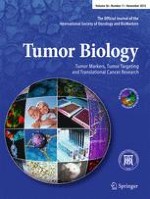Published in:

01-11-2015 | Research Article
ARMc8 indicates aggressive colon cancers and promotes invasiveness and migration of colon cancer cells
Authors:
Guiyang Jiang, Yong Zhang, Xiupeng Zhang, Chuifeng Fan, Liang Wang, Hongtao Xu, Juanhan Yu, Enhua Wang
Published in:
Tumor Biology
|
Issue 11/2015
Login to get access
Abstract
Recent studies have implicated ARMc8 in promoting tumor formation in non-small cell lung cancer and breast cancer; however, so far, no studies have revealed the expression pattern or cellular function of ARMc8 in colon cancer. In this study, we used immunohistochemical staining to measure ARMc8 expression in 206 cases of colon cancer and matched adjacent normal colon tissue. Clinically important behaviors of cells, including invasiveness and migration, were evaluated after upregulation of ARMc8 expression in HT29 cells through gene transfection or downregulation of expression in LoVo cells using RNAi. We found that ARMc8 was primarily located in the membrane and cytoplasm of tumor cells, and its expression level was significantly higher in colon cancer in comparison to that in the adjacent normal colon tissues (p < 0.001). ARMc8 expression was closely related to TNM stage (p = 0.006), lymph node metastasis (p = 0.001), and poor prognosis (p = 0.002) of colon cancer. The invasiveness and migration capacity of HT29 cells transfected with ARMc8 were significantly greater than those of control cells (p < 0.001), while ARMc8 siRNA treatment significantly reduced cell invasion and migration in LoVo cells (p < 0.001). Furthermore, we demonstrated that ARMc8 could upregulate the expression of MMP7 and snail and downregulate the expression of p120ctn and α-catenin. Therefore, ARMc8 probably enhanced invasiveness and metastatic capacity by affecting these tumor-associated factors, thereby playing a role in enhancing the tumorigenicity of colon cancer cells. ARMc8 is likely to become a potential therapeutic target for colon cancer.